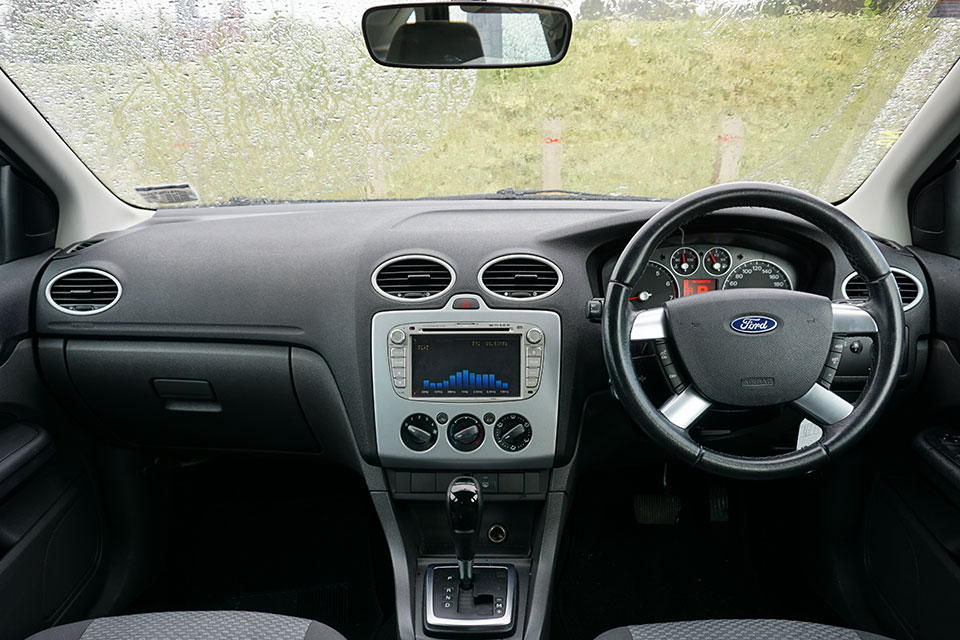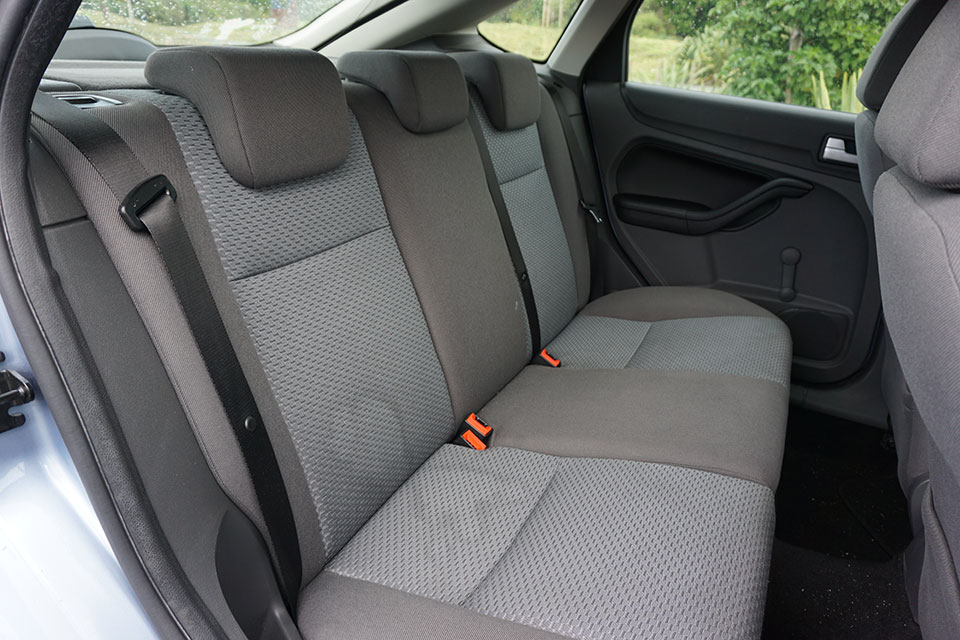Ford Focus 2004-2010 used car review
The Ford Focus is a practical hatchback, with one of the best ride and handling packages available in a family car.

The Ford Focus is a practical hatchback, with one of the best ride and handling packages available in a family car.
The second-generation Ford Focus had a lot to live up to when it launched in 2004. The first Focus was hugely popular thanks to its cutting edge looks, excellent ride and handling. The new version maintained the latter, though it looked far more conservative and less exciting. It was more practical, with additional interior space and a larger boot. Initially, cars sold in New Zealand were built in South Africa, with the source gradually shifting to Germany. Because of this, there can be variation in specification between earlier and later versions.
Inside and out
The most noticeable styling feature of the Focus is its big, chunky wheel arches, which look like they belong on a sports car. The 15-inch steel wheels look small in these massive arches. At the front, the Focus’s trademark angular look has been toned down, and the car appears quite dull. At the rear, the tail lights are high and alongside the back window, which makes them more visible and provides room for a bigger hatchback opening.
The dashboard is made of a soft rubberised plastic which looks and feels like it is of high quality. The air vents are oval to match the Ford badge. The gauges look quite sporty and sit in individual metallic rings. In the centre of the cluster is a red-coloured digital screen for vehicle information. The steering wheel is adjustable for both reach and tilt.
As standard, the Focus gets a basic CD player stereo with steering wheel controls. Our car has had this replaced by an aftermarket touchscreen infotainment system. Base model Focus cars get electric windows only in the front. In the rear are old fashioned wind-up units. The air-conditioning is manual and adjusted using chunky, easy to use knobs.
The front seats are very supportive and feel like they are sized for a bigger car. The driver’s seat is also adjustable for height. Rear seat space is excellent, with a healthy amount of legroom for this class of car. The centre back position is flat, so any passenger who ends up here does not have to ride on a centre ‘hump'. Three smaller adults will fit in this row, although two adults and a child will be more comfortable.
The boot is convenient, with a square shape and a wide opening for loading. Its 375 litre capacity is average for the class, although its shape means you can squeeze a lot in – we expect two large and two small cases to fit. The rear seat splits 60/40 and folds forward almost flat to more than double the available space. Overall the build quality of this car is high.
On the road
The Focus is known for its handling. Far more expensive cars struggle to feel as engaging as this to drive. The steering feels weighty and responsive, with the chunky steering wheel pleasant in your hands. The ride is soft enough to feel comfortable and soaks up bumps, but it does not roll on corners.
The 2-litre engine is less exciting. It produces 107kW and 185Nm, which is average for the class. It does not feel that powerful in real life. A load or hill shouldn’t bother it, though you will need to plan for big overtaking moves. It is a quiet engine, and reasonably refined.
Other options include a 1.6-litre petrol, a 1.8-litre diesel - found only in the wagon version - and a range-topping 2.5-litre five-cylinder turbocharged petrol engine. The four-speed automatic is not very smooth and quite slow to shift. It can be changed manually. A five-speed manual is also an option.
We found visibility out of the Focus excellent in all directions. The rear hatchback window is large, and it is easy to see out. Neither parking sensors or a reversing camera are standard, and we do not think most people will need them.
Automatic Focus hatchbacks can tow 600kg (unbraked), a small-to-medium trailer, or 1,000kg (braked), a tiny boat. Manual models can tow 200kg more. This is low for the class.
Safety
The safety rating of the Focus you are looking at depends on its age. Cars built before May 2007 have a four-star ANCAP rating, while cars made after this date are rated five-stars. Our review vehicle is one of the earlier cars, with standard anti-lock braking, electronic brakeforce distribution and driver and passenger airbags.
It is fitted with optional side airbags. Later model vehicles have both sets of airbags as standard and are all equipped with electronic stability control. This technology was optional in the early cars.
If you are buying a Focus built before 2007, you will need to check if it has ISOFIX child seat mounts in the outside window positions. Thanks to Australian regulations they were not fitted to the South African-built cars. They are standard on the German built ones. All three rear seats feature full shoulder-type belts, which offer more protection than the lap-only type.
Reliability
The 2-litre engine powering the Focus is made by Mazda and has a reasonable record of reliability. It has a timing chain that does not need to be regularly replaced. It can suffer from small oil leaks from the rocker cover, fixed by the replacement of a gasket costing around $300. The intake manifold solenoid can also fail, which will cause the engine light to come on and may put the car into a ‘limp home’ mode. This costs around $400 to replace.
The only solution is a replacement, which you can do with a refurbished unit from $300. Power steering hose leakage is another common Focus problem. If not identified and repaired in time it can lead to damage to the power steering rack. The easiest way to check is to inspect the underside of the car for any signs of red power steering fluid seeping around the engine bay or collecting on the undertray.
At higher mileages, over 150,000km, automatic transmissions can begin to fail. The first signs of this are harsh shifting, which feels like a thump between gears. The cause of this is a faulty shift between changes. If caught early, a basic overhaul costing from $1,000 can fix the issue. If not caught early a replacement transmission may be required.
This can prevent the shifter from getting into Park, blocking the car from starting.The base model Focus features light grey interior upholstery. This fabric appears to be very prone to staining and after family use, the seats in our review vehicle were looking a little grubby.
Cost of ownership
Regularly servicing the Focus is relatively affordable. It is recommended you do this every year or 20,000km. Each service costs $300 under Ford’s fixed price service system. The Focus is known to be heavy on its brakes. While they are not expensive service items, factor in the need to have them checked and replaced more frequently.
RightCar estimates that over 14,000km of driving a year, a Focus will cost $2,240 to fuel. The 55-litre fuel tank will cost $110 to fill and should take you 625km before the fuel light comes on. This consumption is on the high side considering the relatively low level of performance this engine offers.
A vehicle licence for the Focus costs $99.02 a year, with the car in the second-cheapest ACC levy group.
Trade Me Insurance estimates insurance for a Focus valued at $6,560 will cost $43.06* per month. This is $3 cheaper a month than a Mazda3.
Buyers’ guide
This generation of Focus is available on Trade Me priced from $4,000 to $13,000 for later and lower mileage vehicles. XR5 Turbo models are worth significantly more, priced as high as $27,000. Small numbers of high-performance ST and RS models are also now making their way into the country as imports from the United Kingdom.
Ford New Zealand switched its source of Focus cars from South Africa to Germany during 2006, with only small differences in trim and specification between them. The 2007-2008 facelift made safety technology more standard across the range.
Variants
- Base – Powered by either 1.6-litre or 2-litre petrol engines. A wagon is also available with a 1.8-litre diesel engine. Features steel wheels, manual air-conditioning, CD player steering wheel, Bluetooth, front power windows and driver and passenger airbags. A $1,500 option pack is common and adds cruise control, power mirrors, rear electric windows and side airbags.
- Zetec – On top of the base model with the option pack, the Zetec features a body kit, six-CD changer, 16-inch alloy wheels, fog lights and a rear spoiler.
- Ghia – On top of Zetec adds separate climate control settings for the driver and passenger, leather-wrapped steering wheel and shifter and wood trim on the centre console.
- XR5 Turbo – Powered by a 2.5-litre five-cylinder turbocharged petrol engine. On top of Zetec adds a sports steering wheel, heated Recaro sports leather seats, electronic stability control, premium stereo, 18-inch alloy wheels, additional sports gauges on the dashboard, carbon fibre trim, more extreme body kit and spoiler.
Timeline
- 2004 Launched globally
- 2005 XR5 Turbo model added
- 2008 Facelifted, with updated styling for the front and rear of the car and changes to the dashboard
- 2010 Replaced by new model
Details
2007 Ford Focus (base)
$5,300 to $24,000 for models which have travelled 70,000 to 120,000km
2-litre four-cylinder, 107kW/185Nm (claimed)
Six-speed automatic, front-wheel drive
Four-star Used Car Safety Rating
20,000km or two year
Full size steel wheel
8-litres per 100km (claimed)
Regular
4340mm
1840mm
1500mm
600kg (unbraked), 1000kg (braked)
10.7m
This review covers the Ford Focus for model years 2004, 2005, 2006, 2007, 2008, 2009 and 2010.
Review vehicle supplied by Turners Cars.
*Our insurance estimates are based on a 35-year-old male with no accidents in the last two years, garaging the car in Mission Bay, Auckland. The car is not used for business and will cover 10,000km to 20,000km a year. We estimate with no option add-ons and $500 excess. Customise your estimate at Trade Me Insurance.
Image gallery
Also consider






